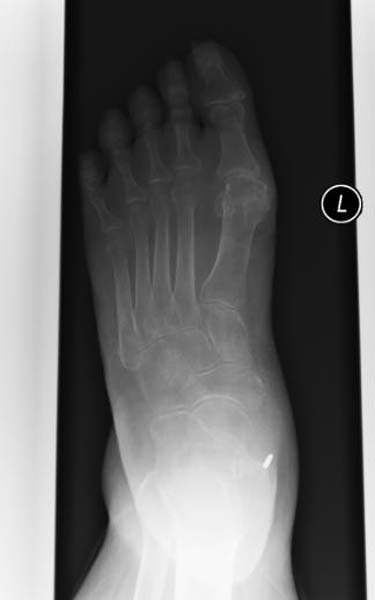Gout x ray
Jump to navigation
Jump to search
|
Gout Microchapters |
|
Diagnosis |
|---|
|
Treatment |
|
Case Studies |
|
Gout x ray On the Web |
|
American Roentgen Ray Society Images of Gout x ray |
Editor-In-Chief: C. Michael Gibson, M.S., M.D. [1]
Please help WikiDoc by adding more content here. It's easy! Click here to learn about editing.
Overview
X-ray findings of Gout varies depending on the type of episode. Acute attack of gout doesn't demonstrate any significant changes, while chronic gout may show subcortical swellings, intraarticular erosions and other findings, which are not significantly diagnostic for gout.
X-ray
- Plain radiographs are often normal, although evidence of asymmetrical swelling and subcortical cysts without erosion may help to diagnose chronic gout.[1]
- Radiographic changes are a late feature of chronic gout, typically occurring after 15 years of disease onset, and is almost always present in patients with subcutaneous tophi.[2]
- Bone erosion is a feature of advanced gout and is characterized by a sclerotic rim and overhanging edge.[3]
- The joint space is usually preserved until late in the disease, and other features such as periosteal new bone formation, extra-articular erosions, intraosseous calcifications, joint space widening, and subchondral collapse may be present.[4]
Patient #1
Patient #2
Sources
Copyleft images obtained courtesy of RadsWiki [2]
References
- ↑ Zhang W, Doherty M, Pascual E, Bardin T, Barskova V, Conaghan P, Gerster J, Jacobs J, Leeb B, Lioté F, McCarthy G, Netter P, Nuki G, Perez-Ruiz F, Pignone A, Pimentão J, Punzi L, Roddy E, Uhlig T, Zimmermann-Gòrska I (October 2006). "EULAR evidence based recommendations for gout. Part I: Diagnosis. Report of a task force of the Standing Committee for International Clinical Studies Including Therapeutics (ESCISIT)". Ann. Rheum. Dis. 65 (10): 1301–11. doi:10.1136/ard.2006.055251. PMC 1798330. PMID 16707533.
- ↑ Nakayama, Denny A.; Barthelemy, Carl; Carrera, Guillermo; Lightfoot, Robert W.; Wortmann, Robert L. (1984). "Tophaceous Gout: A Clinical and Radiographic Assessment". Arthritis & Rheumatism. 27 (4): 468–471. doi:10.1002/art.1780270417. ISSN 0004-3591.
- ↑ Neogi T, Jansen TL, Dalbeth N, Fransen J, Schumacher HR, Berendsen D, Brown M, Choi H, Edwards NL, Janssens HJ, Lioté F, Naden RP, Nuki G, Ogdie A, Perez-Ruiz F, Saag K, Singh JA, Sundy JS, Tausche AK, Vaquez-Mellado J, Yarows SA, Taylor WJ (October 2015). "2015 Gout classification criteria: an American College of Rheumatology/European League Against Rheumatism collaborative initiative". Ann. Rheum. Dis. 74 (10): 1789–98. doi:10.1136/annrheumdis-2015-208237. PMC 4602275. PMID 26359487.
- ↑ Resnick D, Broderick TW (December 1981). "Intraosseous calcifications in tophaceous gout". AJR Am J Roentgenol. 137 (6): 1157–61. doi:10.2214/ajr.137.6.1157. PMID 6976085.






